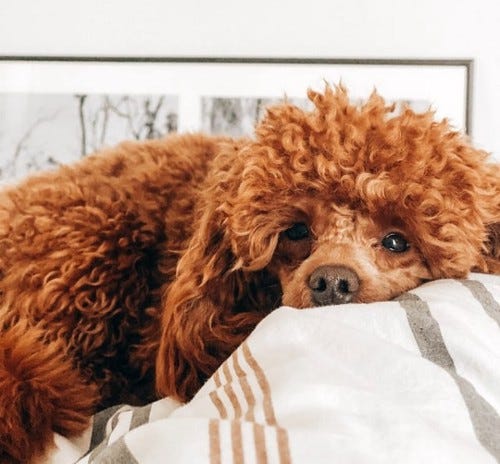Potty training and pups: When carpet gets peed on more than grass
Tips for house-training and crate-training your dog

If you’re a dog owner who is trying to crate-train or house-train your pup, you’ve done that Flo-Jo race to the door. The harness is in one hand, and the leash is in another. Or, you’ve reached inside of the crate to hook the leash and jogged your way to the door. You know if you don’t move fast, your dog will get out of the crate, hike a leg or squat, and let loose all over your rug. In her mind, she’s released herself. In yours, that was the entire point of the walk. You sigh and turn around to grab the pet odor eliminator spray.
ADVERTISEMENT ~ Amazon
As an Amazon affiliate, I earn a percentage from purchases with my referral links. I know some consumers are choosing to boycott Amazon for its DEI removal. However, after thinking about this thoroughly, I want to continue promoting cool products from small businesses, women-owned businesses and (specifically) Black-owned businesses who still feature their items on Amazon. As of the first date of Black History Month 2025, each new post will ALWAYS include a MINIMUM of one product sold by a Black-owned business. (I have visited the seller’s official site to verify that Amazon Black-owned logo.) I am (slowly) doing this with older, popular posts too. If you still choose to boycott, I 100% respect that decision.
Your dog is going to react in one of two ways: She’ll run underneath the table because she knows she’s done something wrong but just can’t help herself. Or, she’ll let you clean it up and then pee again. (You’ll swear she’s laughing on the inside.) You are not alone. It takes a lot of time and patience to get a dog to stop releasing herself all over your carpet, rugs or hardwood floor. And once she’s marked it, you better believe she’s going right back to that area over and over again.
By now you know that crate-training and house training takes a lot of patience and many accidents. Just as you wouldn’t expect a baby to come crawling out her mom and say, “Nah, I’m good, just show me where the restroom is” when you try to put a diaper on her, don’t expect the average dog to be a dog walking genius in her puppy years — minus one.

There are plenty of posts online about crate-training, including from the American Kennel Club. But here are a couple of easy tips I’ve learned in between the basics.
Tip 1 (Keep treats outside the door): While AKC recommends giving a dog a treat to go inside of a crate, consider making it a routine to give that dog a treat for making it outside of the door. If she knows there’s a treat coming, she may be more likely to not make pit stops on your rug.
ADVERTISEMENT ~ Amazon
As an Amazon Affiliate, I earn a percentage for each purchase with my referral links.

According to AKC, “A good rule of thumb is that your puppy can hold their bladder for one hour for every month old they are. For example, if your puppy is 8 weeks old, they probably can’t hold it for longer than 2 hours. When they hit 12 weeks, it’s around 3 hours.”
Tip 2 (Don’t forget a blanket): If you live in an apartment — and not on the first floor — chances are you’ll have to carry your dog down those steps. Never become so overly confident that you think the dog will not pee on you. A mini Schnauzer felt especially warm and snuggled up close to my chest and neck. My heart was so warm for how affectionate this dog was, as I jogged down three flights of steps. I put him down and realized my winter coat was warm too — with pee from breast to waist. I scooped up a pile of snow to clean it off and kept it moving. In those early days,




